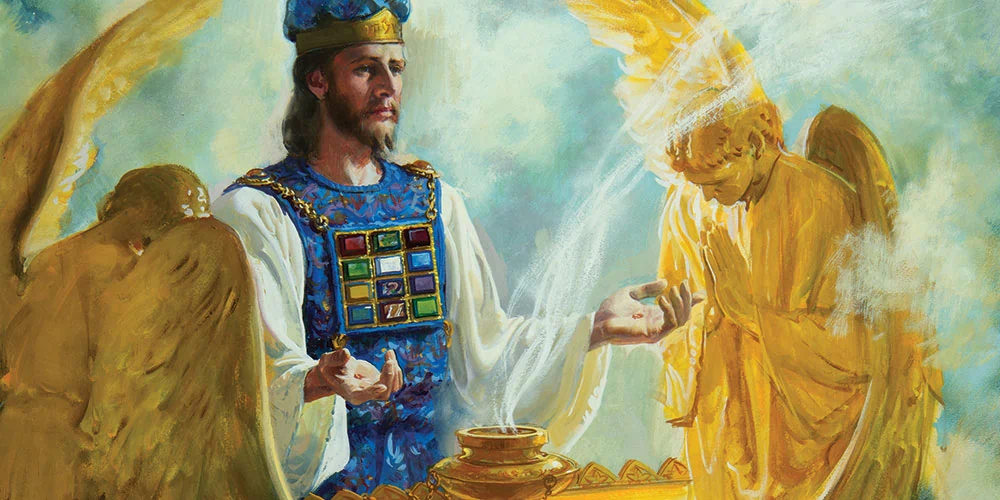
The doctrine of the sanctuary lies at the foundation of Seventh-day Adventist theology and mission and constitutes the most distinctive contribution of Adventism to Christian thought.
While other Adventist “distinctives” (seventh-day Sabbath, state of the dead, tithing, etc.) are taught by various Christian denominations, the Seventh-day Adventist Church is the only major faith-group teaching the “good news” of the three angels’ messages—that in these last days of earth’s history, “the hour of His judgment has come” (Rev. 14:6, 7). Adventists believe that at the beginning of the antitypical day of atonement, October 22, 1844, Jesus, our High Priest, entered the Most Holy Place of the heavenly sanctuary to conduct a pre-Advent judgment vindicating His people and bringing justice against all evil (Lev. 16; Dan. 7:9, 10, 21; 8:14).
For Adventist pioneers, “the subject of the sanctuary was the key which unlocked the mystery of the disappointment of 1844. It opened to view a complete system of truth, connected and harmonious, showing that God’s hand had directed the great advent movement and revealing present duty as it brought to light the position and work of His people.”1
The sanctuary message is not just one doctrine among many in Seventh-day Adventist theology. In 1906, Ellen White could write, “The correct understanding of the ministration in the heavenly sanctuary is the foundation of our faith.”2 Adventist scholars, both past and present, have shown how the sanctuary is the center of all the major doctrinal truths in the Bible.”
The Sanctuary: a Beautiful MessageThe sanctuary message is a revelation of the beauty, truth, and goodness of God (Ps. 27:4, 13). In contrast to most Christian theological systems, constructed around the Platonic notion of a timeless God who is incompatible with spatio-temporal reality, Seventh-day Adventists offer a corrective to what they consider a distortion of the nature of God.
Scripture reveals a God who enters space and time, who dwells in a real place in the universe—His heavenly temple/palace: Isaiah 6:1-9 is but one of multiple examples. From the time the universe was created, even before the rise of sin and evil, God has invited us to enter into personal and intimate fellowship with Himself. Israel’s earthly sanctuary/temple, a “miniature representation” of the heavenly original, had this same major function (Ex. 25:8, 9). The sanctuary doctrine is thus the embodiment of the Immanuel principle—“God with us” (Isa. 7:14).
The sanctuary doctrine focuses upon Jesus in the sanctuary, including (1) His atoning work on the cross, which functions as the sacrificial altar of the heavenly sanctuary (see Heb. 13:10); (2) His heavenly ministration of intercession for us (Heb. 7:25); and (3) His work of vindicating His people during the pre-Advent judgment (Dan. 7:22). If we really want to focus upon Jesus, then we need to concentrate on where Jesus is now, applying the benefits of His atoning work on Calvary for us personally in the heavenly sanctuary (Heb. 7-10). The sanctuary message is a window into the heart of the Triune God, and involves the united work of Father, Son, and Holy Spirit.
Most people today are fascinated by the concept of a sanctuary, but paradoxically, little attention is given to the sanctuary message of the Bible. However, the biblical doctrine of the sanctuary embraces all of the main meanings of sanctuary recognized by secular society today—and far exceeds the most lofty conceptions of sanctuary humans can imagine. The biblical sanctuary is a sacred place—both here on earth and in heaven—where beings come to worship God (Ps. 150:1); it is the command center of the universe where angelic hosts come and go in the loving service of their Commander (Isa. 6:6-7). The sanctuary is also a place of refuge, where God is engaged in saving the endangered species of humankind (Ps. 27:5). The sanctuary is a place of safety and quiet, where God invites His people to come by faith and escape the hectic and threatening pace of today’s living (Heb. 4:16; 10:19-22).
The pre-Advent judgment message of the sanctuary has sometimes been understood in such a way as to bring fear into the hearts of those who do not feel they are good enough to face the Divine Judge. But the biblical message of this judgment is good news about Jesus (Rev. 14:6, 7).
In this message we see that Jesus is (1) our Substitute, who has paid the price for our sins (Isa. 53:6); (2) our Lawyer, who has never lost a case committed to Him (1 John 2:1); (3) our Star Witness, who testifies in our favor against the false charges of Satan (Rev. 3:4); (4) our Judge, who is on our side (John 5:22); (5) our Purifier, taking responsibility for our moral cleansing (Ezek. 36:25-27); (6) our Vindicator, who pronounces judgment “in favor of the saints” and brings retributive justice against those who have maligned and mistreated God’s people (Dan. 7:22, 26); and (7) the Vindicator of God’s character, so that the whole universe will eventually declare, “Just and true are Your ways, O King of saints!” (Rev. 15:3, NKJV).3
For God’s people, the verb “judge” in the Bible has positive implications: “justify” (Rom.3:22-26;5:6-11); “save” (Isa. 35:4); “deliver” (Ps. 9:7-10); “vindicate” (Ps. 135:14). In this world of injustice, oppression, abuse, suffering, slander, and evil, the God of justice and mercy is in the heavenly sanctuary, working it all out to bring justice to all wrongs done in the universe, and salvation and vindication to all those who trust in Him. The lyrics of Michael Card’s song “Jubilee” capture the “good news” of the sanctuary judgment message: “To be so completely guilty and given over to despair, to look into your Judge’s face and see a Savior there!”
Richard Davidson is the J. N. Andrews professor of Old Testament Interpretation at the Seventh-day Adventist Theological Seminary, Berrien Springs, Michigan.